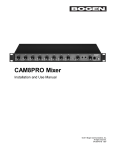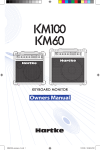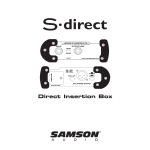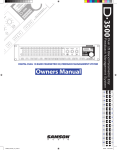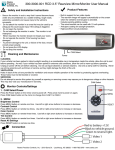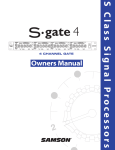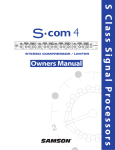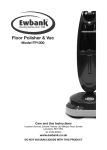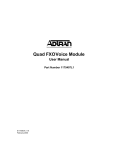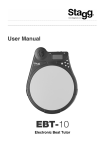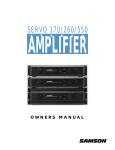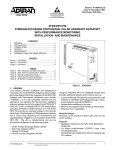Download the S-xover User Manual in PDF format
Transcript
��� ���� �� ��� �� ��� � ����� �� ��� ��� ��� ��� ���� ��� �� ��� ��� ���� ���� ��� ���� ��� ���� �� ����� ��� ���� ������������������ ����� �� ������� �������� �������� ������� ��� ����� ������������������������������ ������������������������������������ Stereo Two-way Electronic Crossover sxover_ownman.indd 1 S Class Signal Processors � � 6/8/04 9:21:36 PM Table Of Contents Introduction and Features Front and Rear Panel Layout Operating the S xover Setting Up the S xover Mono Sub Set-up Wiring Guide Specifications 3 4 5-6 7 8 8 Copyright 2004, Samson Technologies Corp. Printed June 2004 Samson Technologies Corp. 575 Underhill Blvd. P.O. Box 9031 Syosset, NY 11791-9031 Phone: 1-800-3-SAMSON (1-800-372-6766) Fax: 516-364-3888 www.samsontech.com sxover_ownman.indd 2 6/8/04 9:21:38 PM S xover Introduction and Features Introduction Congratulations on your purchase of the S xover by Samson Audio! The S xover is a full featured, stereo, two-way electronic crossover perfect for a variety of bi-amp speaker applications in studio monitoring, live sound and fixed installations. With individual controls for Input Level, as well as High and Low Frequency outputs, the S xover is small, but not short on features. For expanded control, the S xover provides a Range switch allowing you to adjust crossover frequency by ten times so you can configure a speaker system with drivers from subs to tweets. The S xover, with its Mono Low switch, is a perfect complement if youʼre adding a subwoofer to a studio monitor or PA system when using a common subwoofer with stereo satellite speakers. Whatever your exact situation, the S xover will provide high quality and reliable performance thanks to its solid build construction based around the extruded aluminum chassis and oversized rubber bumper feet. In this manual, youʼll find a more detailed description of the features of the S xover, as well as a guided tour through the front and rear panels, step-by-step instructions for using the S xover, and full specifications. Youʼll also find a warranty card enclosed—please donʼt forget to fill it out and mail it so that you can receive online technical support and so we can send you updated information about other Samson products in the future. S xover Features • Two-way Stereo Electronic Crossover • Adjustable Crossover frequency control. • High and Low Level Outputs. • Input Level Control. • Range control covering frequencies from subs to tweeters. • Mono Low switch for operating sub satellite system woofers. • Large rubber bumper feet. • Three year extended warranty. 3 sxover_ownman.indd 3 6/8/04 9:21:39 PM S xover Front and Rear Panel Layout Front Panel Layout � � � � � � � � ��� ���� �� ��� ��� ���� �� ��� � ����� �� ��� ��� ��� ��� ���� ��� ���� ��� ���� �� ��� ��� ���� �� ����� ��� ���� 1 LEVEL- Used to adjust the input gain from –00 to +0dB. 2 LOW - Adjusts the output gain of the Low frequency bands from -12 to +12dB. 3 HIGH - Adjusts the output gain of the High frequency bands from -12 to +12dB. 4 FREQUENCY CONTROL- This control that sets the crossover point dividing the frequency bands. 5 RANGE SWITCH - Selects the range at which the frequency control operates, either normal or times 10. MONO LOW - Selects mono operation for the low output. 6 Rear Panel Layout � � � � � ������������������ ����� �� ������� �������� �������� ������� ��� ����� ������������������������������ ������������������������������������ A IN LEFT - 1/4-inch line level input for the Left channel. C HIGH OUT - TRS connector with Left and Right High frequency line outputs. B IN RIGHT - 1/4-inch line level input for the Right channel. D LOW OUTPUT - TRS connector with Left and Right Low frequency line outputs. E POWER IN DC INLET - Connect the supplied power adapter here. 4 sxover_ownman.indd 4 6/8/04 9:21:40 PM Operating the S xover Setting Up the S xover The basic procedure for setting up and using your S xover is simple and takes only a few minutes. Remove all packing materials (save them in case of need for future service). There are many different ways to use the S xover, however the basic connection is the same in most installations and applications. The following example details a typical 2-way stereo sound system for using a bi-amp power arrangement. Follow the steps below to connect your bi-amp system. � � ��� ����� �� ��� ������������ ��� ���� �� ��� � ����� �� ��� ��� ��� ��� ���� ��� �� ��� ���� ��� ���� �� ��� �� ����� ��� ���� ������ ����� ������������������ ����� �� ������� �������� �������� ������� ������������� ��� ����� ������������� ������ ��������� Servo 550 Power Amp (High) �������������������������� CAUTION RISK OF ELECTRIC SHOCK DO NOT OPEN ����� ���������� ������ FUSE FUSE RATING ������������������������������������������������ ! SERIAL NUMBER BRIDGED MONO STEREO 12A/250V (115V) 6A/250V (230V) USE CLASS 2 WIRING MAXIMUM LOAD IMPEDANCE 4� LEFT CAUTION HEATSINK MAY BE HOT! DO NOT BLOCK AIRFLOW OR OVERHEATING MAY OCCUR TO PREVENT SHOCK DO NOT OPEN. NO USER S E R V I C A B L E PA R T S INSIDE. REFER SERVICING TO QUALIFIED SERVICE PERSONNEL. TO PREVENT FIRE OR SHOCK HAZARD DO NOT EXPOSE TO RAIN OR MOISTURE. +RIGHT GROUND RIGHT LEFT+ INPUTS (BALANCED 10K�/0dBm0) OUTPUT 250W/4� TIP RING SLEEVE RIGHT LEFT TIP + RING SLEEVE GND ~AC INPUT 115V/230W, 50/60HZ 510W (115V)900W (230V) �������� S1500 Power Amp (Mid) ���������� OUTPUT INPUT PUSH TO RESET 20A/250V (4�~8�) (4�~8�) (4�~8�) (4�~8�) CH 2 CH 1 BALANCED 0dBm TIP=HOT TRS RING=COLD BALANCED SLEEVE=GND ~AC INPUT 115V 60Hz, 920W BALANCED 0dBm XLR BALANCED CH 2 BRIDGED 3=COLD 2=HOT 1=GND CH 1 PARALLEL STEREO • ��������� Connect the AC/DC power adapter to the DC inlet, but donʼt plug the AC/DC power adapter in just yet. 5 sxover_ownman.indd 5 6/8/04 9:21:42 PM Operating the S xover Setting Up the S xover • Set the LEVEL, LOW and HIGH Output controls all the way down by turning them fully counter clockwise. • Using two standard 1/4-inch phone cables, connect the your mixerʼs left and right output to the S xoverʼs LEFT and RIGHT INPUT. • Use a “Y” cable with a 1/4-inch TRS (TIP RING SLEEVE) to two 1/4-inch TS (TIP SLEEVE) to connect the Left and Right LOW Output to the power amp connected to the low frequency drivers. For a detailed wiring diagram for the 1/4-inch TRS "Y" cable see page 8 in this manual. • Use a second “Y” cable with a 1/4-inch TRS (TIP RING SLEEVE) to two 1/4-inch TS (TIP SLEEVE) to connect the Left and Right HIGH Output to the power amp connected to the high frequency drivers. • At this point connect the power amplifiers to the low and high frequency speakers following the manufacturers recommended procedures outlined in their individual owner manuals. • Set the position of the RANGE switch so that the FREQ control is operating in the desired frequency range. The Range control operates from 35 Hz to 800 Hz when the RANGE switch is out, but with the RANGE switch in the frequency is multiplied by 10 times so the range becomes 350 Hz to 8 kHz. • Once the RANGE switch is properly set, use the FREQ control to set the crossover point between the low and high frequency driver. Be sure to check with the speaker manufacturerʼs recommended operating range for the individual drivers to avoid any serious damage that may result. • Now, plug in the AC/DC adapter while appling the “Golden Rule of Audio” to power up your system. IMPORTANT NOTE: The “Golden Rule of Audio” - LAST ON / FIRST OFF When running a loudspeaker system with one or multiple power amplifiers, it is highly recommended that you follow the LAST ON / FIRST OFF rule. When powering up your sound system, turn your power amplifier on last. When you power down your system, turn your power amplifiers off first. This will prevent any switching spikes you may get from other gear in your system, and help prevent unnecessary pops that can sometimes cause speaker damage. • Run a signal from your mixer( like from a CD or MP3 player) and adjust the output level so a good signal is sent to the S xover. Now adjust the LEVEL control to about half way up. • Finally, set the LOW and HIGH controls to about half-way and adjust the levels with an RTA (REAL TIME ANALYZER), like a Samson D1500, or use your ears to dial in the blend between the low and high drivers. 6 sxover_ownman.indd 6 6/8/04 9:21:44 PM S xover Sub System Set-up Typical Set-up for Satellite systems with Mono Sub The diagram below shows a typical set-up for using the S xover with a sub woofer for PA application using full range speakers in stereo along with a common sub running in mono. You can use the same type of hook-up for connecting a sub woofer to full range studio monitors in recording set-ups. Set the RANGE switch out and the Mono switch in and follow the diagram below to connect your system. 7 sxover_ownman.indd 7 6/8/04 9:21:48 PM S xover Specifications 1/4-inch TRS (TIP RING SLEEVE) to two 1/4-inch TS (TIP SLEEVE) INSERT Y CABLE Wiring Diagr Frequency Response 10Hz to 160kHz, -1dB Dynamic Range Noise Level >95dB -80dBu THD .003% typical, 1% at +15dBu out Maximum Ouput Level Max Input Level Input Impedance Output Impedance +15 dBu +22 dBu 10k Ohm 100 Ohm Dimensions 5.65” L x 4.13” W x 2” H (144mm L x 105mm W x 51mm H) 16.5 oz., 419 gm. Weight Samson Technologies Corp. 575 Underhill Blvd. P.O. Box 9031 Syosset, NY 11791-9031 Phone: 1-800-3-SAMSON (1-800-372-6766) Fax: 516-364-3888 www.samsontech.com sxover_ownman.indd 8 6/8/04 9:21:58 PM









